Indus Valley Civilization | General Awareness for SSC CGL PDF Download
The Indus Valley Civilization (IVC) is very important in India's history. It is also known as the Harappan Civilization because the city of Harappa was discovered by Daya Ram Sahni in 1921 near the Ravi River. This civilization is a key topic for the SSC CGL Exam as it laid the foundation for later Indian cultures.
In this document , we will explore various aspects of the Indus Valley Civilization, including its background, discovery, geographical extent, important sites, socio-political features, economic aspects, cultural characteristics, town planning, different phases, and the decline of the civilization.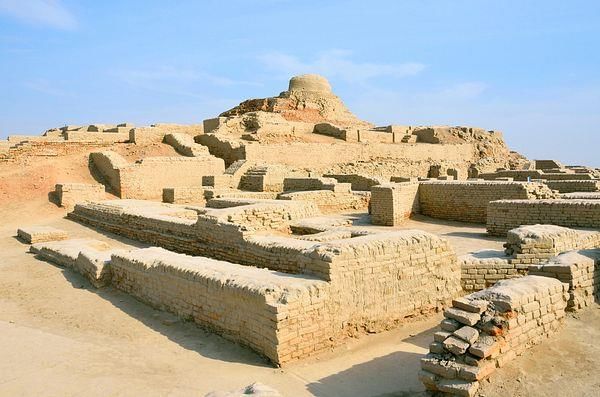
Background of the Indus Valley Civilization
- The Indus Valley Civilization was one of the first urban cultures in the world.
- It flourished around 2500 BCE in present-day Pakistan and northwest India.
- This civilization is known for its advanced city planning and architecture.
- It had a well-organized social structure.
- The Indus Valley Civilization remains a major topic of interest and study.
Indus Valley Civilization: Discovery
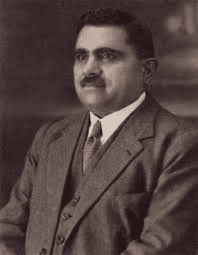 Daya Ram Sahni
Daya Ram Sahni
- The civilization was first found in the 1920s when archaeologists discovered the city of Harappa.
- Later digs uncovered other important sites like Mohenjo-Daro.
- This led to recognizing a large and advanced ancient culture.
Indus Valley Civilization: Geographical Extent
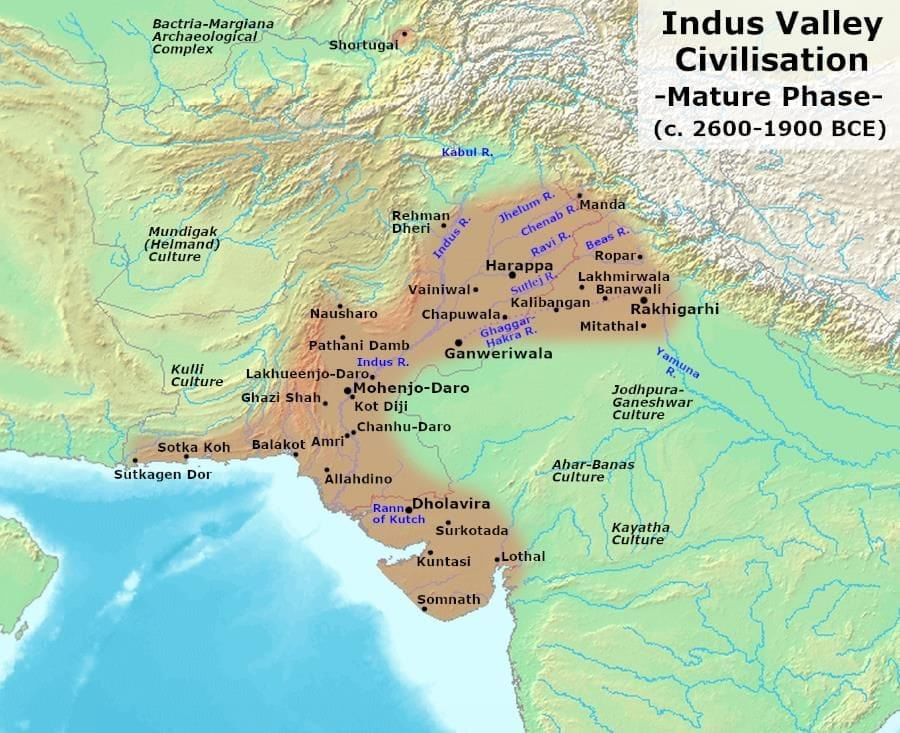
- The Indus Valley Civilization was a large ancient civilization.
- It was located in parts of present-day Pakistan, India, and Afghanistan.
- The civilization thrived in the fertile plains of the Indus River and its tributaries.
- This fertile land helped in supporting agricultural activities.
Important sites of Indus Valley Civilization
- Major sites of the Indus Valley Civilization include Harappa, Mohenjo-Daro, Dholavira, Lothal, and Kalibangan.
- Each site unique features, but all shared common features of urban planning and architecture.
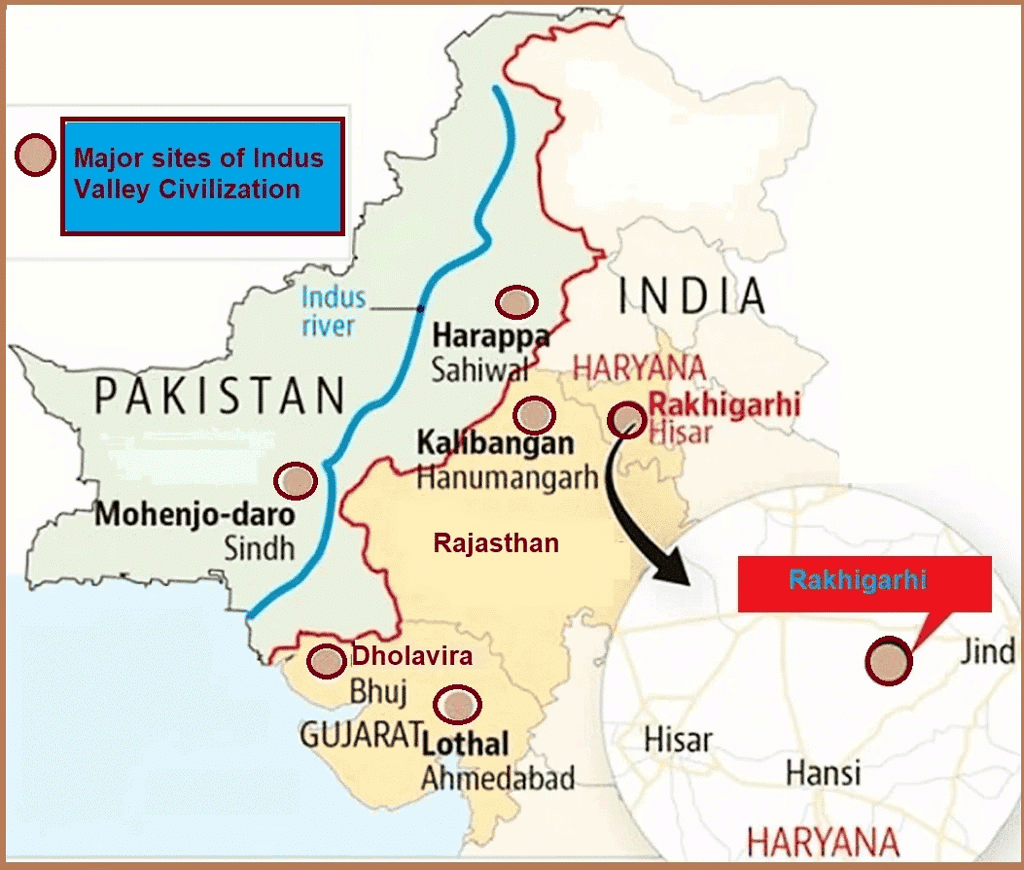
Harappa
- Discovered by: Marshall, Rai Bahadur Daya Ram Sahni, and Madho Sarup Vats in 1921
- Location: Montgomery district of Punjab, on the banks of the Ravi River
- Features: Granaries, bullock carts, sandstone human anatomy sculptures
Mohenjo-daro
- Discovered by: R.D. Banerjee, E. J. H. MacKay, and Marshall in 1922
- Location: Larkana district, Punjab, on the banks of the Indus River
- Features: Mound of the Dead, Great Bath, Bronze dancing girl, Seal of Pashupati Mahadeva statue, Steatite of bearded man, Numerous seals, Agricultural innovation with early cotton cultivation, Domesticated animals including sheep, goats, and pigs
Sutkagendor
- Discovered by: Stein in 1929
- Location: Dast river in Pakistan's southern Balochistan province
- Features: Trading post linking Harappa and Babylon
Chanhudaro
- Discovered by: N.G. Majumdar in 1931
- Location: Sindh, on the Indus River
- Features: Shop with bead makers, Depiction of a dog chasing a cat's footprint
Amri
- Discovered by: N.G. Majumdar in 1935
- Location: Banks of the Indus River
- Features: Evidence of antelope
Kalibangan
- Discovered by: Ghose in 1953
- Location: Rajasthan, beside the Ghaggar River
- Features: Altar of fire, Camel bones, Wooden plough
Lothal
- Discovered by: R. Rao in 1953
- Location: Gujarat, on the Bhogva river near Gulf of Cambay
- Features: First artificial port, Dockyard, Rice husk, Altars of fire
Surkotada
- Discovered by: J.P. Joshi in 1964
- Location: Gujarat
- Features: Horse-like skeletons, Beads
Banawali
- Discovered by: R.S. Bisht in 1974
- Location: Hisar district, Haryana
- Features: Beads, Barley evidence, Pre-Harappan and Harappan cultures
Dholavira
- Discovered by: R.S. Bisht in 1985
- Location: Gujarat, Rann of Kachchh
- Features: Water collection system, Reservoir
Salient Features of the Indus Valley Civilization
Town Planning
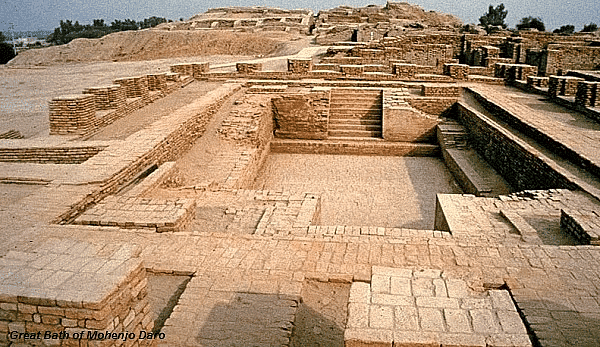
- Harappan civilization had well-planned cities.
- Harappa and Mohenjodaro each had a high area for rulers.
- Regular people lived in brick houses below the ruler's area.
- They organized houses in the city in a grid pattern.
- Granaries were important buildings in Harappan cities.
- Harappan towns used burnt bricks, unlike Egyptians who used dry bricks.
- Mohenjodaro had an impressive drainage system.
- The Great Bath in Mohenjodaro was a significant public place.
- The Bath had steps, dressing rooms, and a floor made of burnt bricks.
- Water for the Bath was drawn from a large well.
- A large granary was a major structure in Mohenjodaro.
- Harappa had six granaries in its citadel.
- Most properties in cities had their own courtyard and bathroom.
- Kalibangan residences had wells.
- Some Harappan locations like Dholavira and Lothal were fortified.
Economic Life
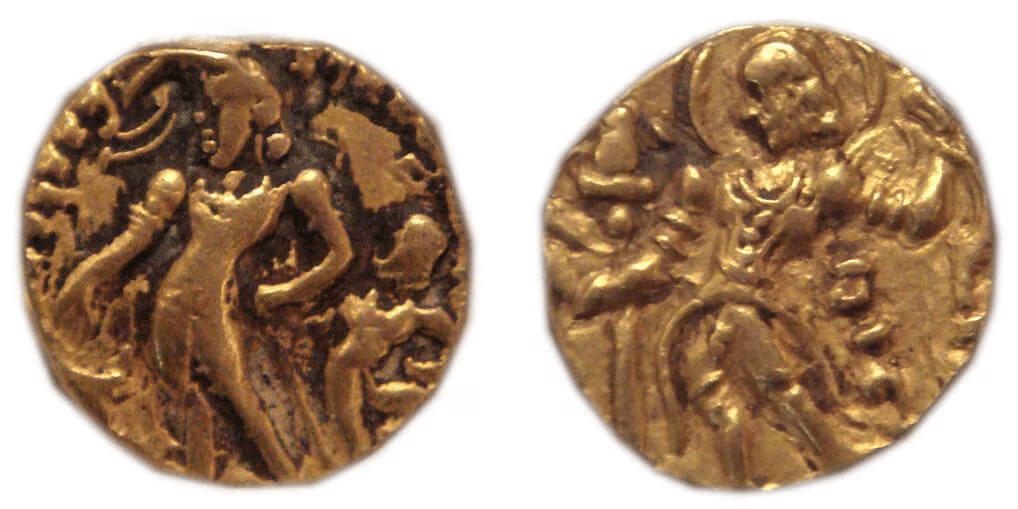
- The Indus people valued trade and used different seals to help with it.
- They had a common writing system and used standardized weights and measures for trading.
- Instead of using metal coins, they traded goods through barter.
- They traveled along the shores of the Arabian Sea for trading purposes.
- They set up a trading outpost in northern Afghanistan to help trade with Central Asia.
- Their trade connections reached areas near the Tigris and Euphrates rivers.
- Harappans traded lapis lazuli over long distances, which may have increased the status of their ruling class.
Agriculture
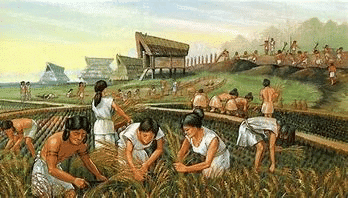
- Harappan communities mainly lived in river plains and grew different types of food crops.
- They commonly cultivated crops like wheat, barley, rai, peas, sesame, lentil, chickpea, and mustard.
- In Gujarat, they also grew millets, but rice was not very popular.
- The Indus people were the first to start cotton farming.
- Finding whole grains shows they practiced agriculture, but we still have questions about their farming methods.
- Pictures on seals and clay art suggest they used bulls and oxen for plowing.
- Most Harappan sites were in semi-arid areas, so they likely needed irrigation.
- Some traces of canals have been found at the Shortughai site in Afghanistan, but not in Punjab or Sindh.
- Besides farming, Harappans also raised animals on a large scale.
- There are faint traces of horses in Mohenjodaro and a questionable ceramic piece in Lothal, hinting at some horse presence.
- However, horses were not a major part of Harappan civilization.
Social Life
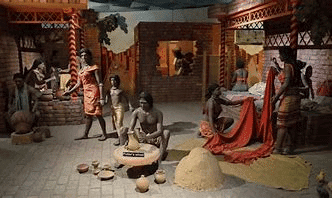
- Both men and women in the Harappan society wore two pieces of cloth - one for the top and one for the bottom.
- Both genders liked to wear beads.
- Women wore many ornaments like bangles, bracelets, fillets, girdles, anklets, earrings, and finger rings.
- These decorations were made from gold, silver, copper, bronze, and semi-precious stones.
- Using cosmetics was common among them.
- At Mohenjodaro, objects made from pottery, stone, shells, ivory, and metal were discovered.
- They used copper to make spindles, needles, combs, fish hooks, and knives.
- Fishing, bullfighting, and hunting were popular activities.
- They made weapons like axes, spearheads, daggers, bows, and arrows from copper and bronze.
Social Institutions
- In the ancient Indus valley, only a few written things have been found, and scholars are still trying to understand the Indus script.
- Figuring out the type of state and organizations that existed in the Indus Valley Civilization is difficult because there are not many clues.
- No temples have been unearthed at any Harappan site. This means that it is unlikely that priests were in charge at Harappa.
- It is probable that a group of merchants held power in Harappa.
- When searching for a central authority or depictions of influential individuals, archaeological records may not offer clear answers.
- Some experts think that in Harappan society, there were no leaders and everyone was treated equally.
Art and Crafts
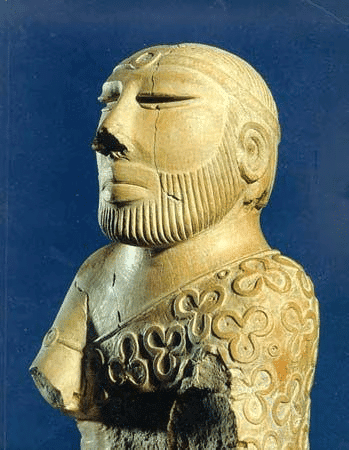
- The Harappans were skilled in making and using bronze.
- They got copper from mines in Rajasthan's Khetri area, and they probably got tin from Afghanistan.
- People found many objects with marks from textiles.
- Big structures made of bricks show that laying bricks was an important skill. This also tells us that there were people who specialized in stonework.
- The Harappans were good at making boats, beads, and seals. They were also good at making things from baked clay.
- Goldsmiths made jewelry from silver, gold, and precious stones.
- They used a potter's wheel to make their own shiny and smooth pottery.
Religion
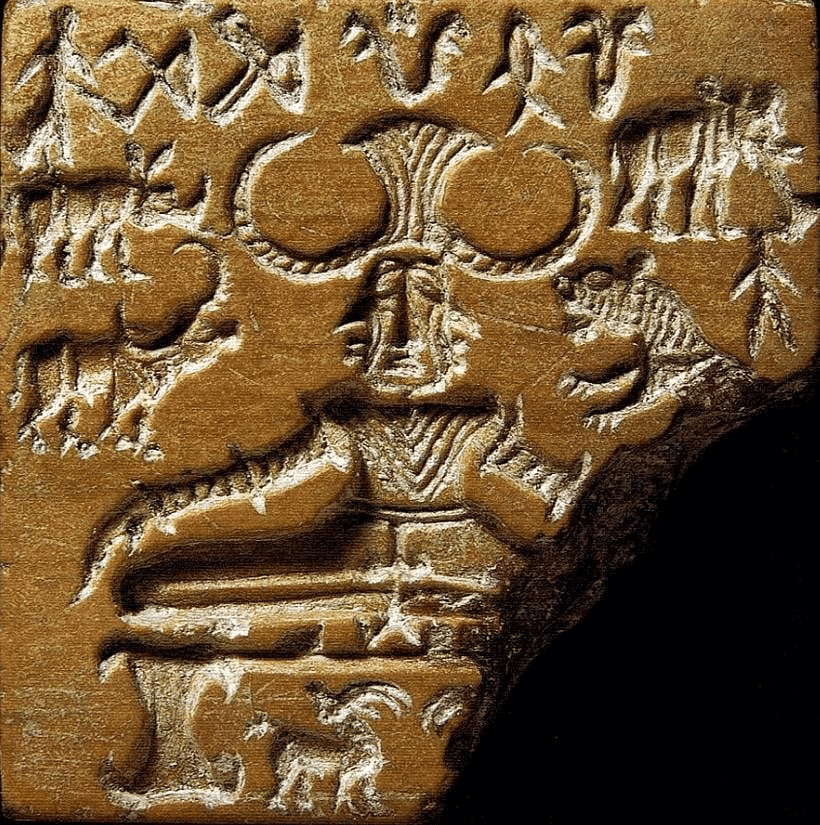
- Clay figures of women were found in Harappa, including one where a plant grows from a woman's body.
- The Harappans saw the earth as a fertility goddess, similar to how the Egyptians honored their goddess Isis.
- A male deity is shown as a seal with three horned heads in a yogi position.
- This deity, named Pushupati Mahadeva, sits on a throne surrounded by elephants, tigers, rhinoceroses, and buffalo, with two deer at his feet.
- Stone symbols of a phallus and a female sex organ have also been found.
- The Indus people greatly respected trees and animals.
- The one-horned unicorn, related to the rhinoceros, was very important, while the humped bull was the second most significant.
- Many amulets have also been discovered.
Script
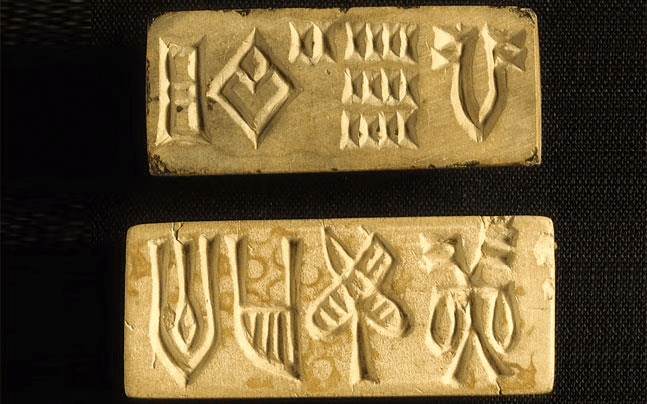
- The Harappan script is still undeciphered.
- There are about 400 to 600 symbols in the script, with 40 to 60 being the most important.
- Most of the writing goes from right to left.
- On some long seals, they wrote in a way called boustrophedon, which means they switched the writing direction on alternate lines.
- Researchers like Parpola and others believe that the Dravidian language was used by the Harappans, and some Soviet scholars agree.
- There are different opinions among researchers about the Harappan and Brahmi scripts.
- The mystery of Harappan writing continues, and figuring it out could give us new information about this ancient civilization.
Burial Methods

- Cemeteries found near towns like Mohenjodaro, Harappa, Kalibangan, Lothal, and Rupar provide insights into how the Harappans buried their dead.
- In Mohenjodaro, people were buried whole or after cremation.
- At Lothal, burial pits were lined with burned bricks, suggesting the use of coffins.
- In Harappa, wooden coffins were also found.
- In Lothal, some burials involved pots, sometimes with pairs of bones. However, there's no solid evidence of the practice of Sati.
Decline of Indus Valley Civilization

- There is no agreement on what caused the Harappan civilization to decline.
- Possible reasons include natural disasters like floods, rivers drying up, soil becoming less fertile due to overuse, and occasional earthquakes.
- Some experts believe that the invasion of Aryans was a significant factor. The Rig Veda talks about forts being destroyed.
- At Mohenjodaro, human bones found close together indicate a possible attack by outsiders.
- The Aryans had better weapons and swift horses, which might have aided in their conquest of the region.
Conclusion
The Indus civilization, also known as the Indus valley civilization or Harappan civilization, was the Indian subcontinent's first known urban culture. The civilization appears to have existed between 2500 and 1700 BCE, however the southern sites may have continued into the second millennium BCE. The Indus civilization was the largest of the world's three early civilizations (the others being Mesopotamia and Egypt).
IVC at Glance

|
477 videos|1438 docs|398 tests
|
FAQs on Indus Valley Civilization - General Awareness for SSC CGL
| 1. What was the geographical extent of the Indus Valley Civilization? |  |
| 2. What are some important sites of the Indus Valley Civilization? |  |
| 3. What are the salient features of the Indus Valley Civilization? |  |
| 4. When and how was the Indus Valley Civilization discovered? |  |
| 5. How did the Indus Valley Civilization contribute to the development of later cultures in the region? |  |






















